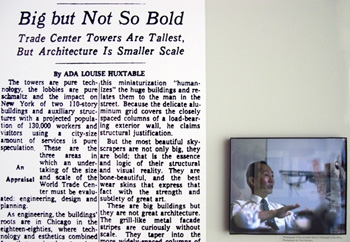
Over the decade of the development and construction of the World Trade Center project , The New York Times architecture critic Ada Louise Huxtable wrote several pieces, from a first, mostly positive reaction to the design unveiled at the January 1964 press conference, to an a brilliant, ambivalent essay in 1966, quoted in our introduction to the exhibition, that asked "Who’s Afraid of the Big Bad Bldgs?" In that piece she placed the ambitions of the project’s planners, architects, and engineers in the broader scope of the ideology in those professions and of inexorable forces of modernization and urban change:
The final, inescapable fact remains that architecture is now breaking scale, and style everywhere. (In his secret heart there is hardly an architect who doesn’t want to do so.) The objective historian realizes that the 20th century is in transition to a remarkable new technology and a formidable new environment. . . Who’s afraid of the big, bad buildings? Everyone, because there are so many things about gigantism that we just don’t know. The gamble of triumph or tragedy at this scale—and ultimately it is a gamble—demands an extraordinary payoff.
Her appraisal in 1973 of the finished buildings, reproduced here, registered her colossal disappointment with the architecture, which she summarized in the afterwards oft-quoted description "General Motors Gothic."
The review precipitated a seven-page letter of response from Minoru Yamasaki. The letter is a thoughtful, point-by-point defense of his architectural principles and of the Trade Center’s design, in many ways as clearly and eloquently stated as Huxtable’s own critique.
Thanks to Leslie E. Robertson for sharing this copy of the letter with the Museum.
 2006 The Skyscraper Museum. |